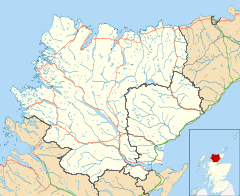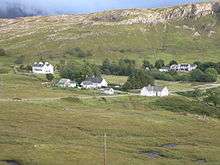Assynt
| Assynt | |
| Scottish Gaelic: Asainte | |
 Ardvreck Castle |
|
 Assynt |
|
| Population | 989 (2001) |
|---|---|
| OS grid reference | NC2092 |
| – Edinburgh | 234 mi (377 km) |
| – London | 637 mi (1,025 km) |
| Civil parish | Assynt |
| Council area | Highland |
| Lieutenancy area | Sutherland |
| Country | Scotland |
| Sovereign state | United Kingdom |
| Post town | Lairg |
| Dialling code | 01571 |
| Police | Scottish |
| Fire | Scottish |
| Ambulance | Scottish |
| EU Parliament | Scotland |
| UK Parliament | Caithness, Sutherland and Easter Ross |
| Scottish Parliament | Caithness, Sutherland and Ross |
Coordinates: 58°12′54″N 5°03′02″W / 58.215°N 5.0505°W
Assynt (Scottish Gaelic: Asainte) is a region and parish in the south-west of Sutherland, Scotland.
It is famous for its landscape (Inverpolly Nature Reserve) and its remarkable mountains (Quinag, Canisp, Suilven, Cùl Mòr, Stac Pollaidh, Ben More Assynt). Knockan Crag National Nature Reserve, which includes a visitor centre interpreting the geological feature the Moine Thrust, is part of the North West Highlands Geopark.[1][2] Assynt hosts the longest cave in Scotland, Uamh an Claonaite, which lies 5 miles (8.0 km) south of Inchnadamph.[3]
The name Assynt may derive from an Old Norse word meaning 'ridge end'. There is also a tradition that the name comes from a fight between the two brothers Unt and Ass-Unt, (meaning Man of Peace and Man of Discord). The latter having won the tussle gave his name to the parish.[4]
In June 2005 the Glencanisp estate, including the mountains Suilven and Canisp and the neighbouring Drumrunie estate, with the mountains Cùl Mòr and Cùl Beag, were bought by the local community.[5] The Assynt Foundation aims to create local employment and safeguard the natural and cultural heritage for the benefit of the community and future generations, and for the enjoyment of the wider public. The estates of Glencanisp and Drumrunie totalling some 18,000 hectares are managed by the Assynt Foundation on behalf of the Assynt community.
North Assynt
Creation of the estate
In 1989, the northwest portion of the Assynt estate was renamed the North Lochinver Estate and put on the market by its owners, the Vestey family. This area consisted almost entirely of crofting land, with 13 crofting townships being set up during the Highland Clearances. The purpose of the sale was to raise money for the owners to buy more hill ground suitable for deer stalking. The estate was purchased by Scandinavian Property Services Limited. Three years later, the company went into liquidation. The North Lochinver Estate was divided into seven lots and put up for sale.[6][7] The sale was handled by an Edinburgh based estate agent, John Clegg and Co.[8] The proposed break-up of the estate was a cause of concern for the crofters as the boundaries of the lots cut across grazing land, creating the possibility of some crofters having to deal with more than one landlord. The crofters also believed that some of the portions would be directly administered by the owners, rather than a professional factor.[9]
Buyout by crofters
The Assynt branch of the Scottish Crofters Union met on the 6 June 1992, to discuss the sale. There the crofters decided to attempt to raise enough money to buy the estate and run it themselves.[10][11]
Assynt Crofters' Trust, a company limited by guarantee, was formed to make a bid for the land. Membership of the trust was open to crofters within the estate. The trust aimed to buy the estate and keep it under the control of the crofters, and to develop the area by initiating projects such as house building, job creation and tree planting.[12] Funding for the trust came from many sources. Each crofting family was asked to raise £1,000. Caithness and Sutherland Enterprise, part of Highlands and Islands Enterprise donated £50,000, while Scottish Natural Heritage gave a grant of £20,000. Highland Regional Council donated £10,000. Much of the money, however, came from a public appeal for funds. This appeal raised over £130,000 from 824 individuals.[13] Money came from throughout the United Kingdom, as well as abroad. Political figures such as the local Member of Parliament, Robert Maclennan,[14] Ray Michie, Alex Salmond, Winifred Ewing and Charles Kennedy donated, as did the rock band Runrig.[13] A secured loan of £90,000 was received from Highland Prospect Limited, a company set up by Highland Regional Council to promote investment in the Highlands by providing grants and low-interest loans.[15]
The trust made two unsuccessful bids, of £235,000 and £245,000 respectively. This caused the trust to adopt a more aggressive stance. They threatened to use right-to-buy provisions of crofting law to buy the crofts.[16] This option, requiring legal action, would be expensive and time-consuming; and would deny the crofters complete control of the estate.[17] The option was therefore kept in reserve in order to make the estate less attractive to other potential bidders—compulsory purchase of the crofts would force the new landowners to sell much of their newly acquired land for a fraction of its value. To assist this strategy, the crofters enclosed and divided an area of common grazing land, an action which would give them the option of buying the common land as well as the crofts themselves. Pressure was also exerted on the main creditor of Scandinavian Property Services, the Swedish Östgöta Enskilda Bank, as the trust wrote telling them of their proposed strategy.[16]
On 4 December 1992, the trust submitted a final bid of £300,000. This was accepted after four days. On Monday, 1 February 1993, Assynt Crofters' Trust became the owners of the North Lochinver Estate, which they renamed the North Assynt Estate.[18]
Settlements

Communities in Assynt include:
- Achmelvich
- Ardvar – location
- Balchladich – location
- Clachtoll – location
- Clashmore
- Clashnessie
- Culkein – location
- Culkein Drumbeg
- Drumbeg – location
- Elphin – location
- Glencoul
- Inchnadamph
- Inverkirkaig
- Kylesku
- Lochinver
- Nedd
- Raffin
- Stoer
Bibliography
- MacAskill, John (1999) We have won the land: the story of the purchase by the Assynt Crofters' Trust of the North Lochinver Estate. Stornoway:Acair. ISBN 0-86152-221-4
References
- ↑ North West Highlands Geopark. North West Highlands Geopark. Retrieved 18 August 2007.
- ↑ "Knockan Crag National Nature Reserve: Rock Art". Scottish Natural Heritage. Archived from the original on 17 August 2007. Retrieved 8 September 2007.
- ↑ "Peter Glanvill Photography: Claonaite" darkanddeep.co.uk. Retrieved 29 September 2007.
- ↑ Strang, Tom. (1975) The Northern Highlands. Edinburgh. Scottish Mountaineering Club.
- ↑ Assynt group buys estates in deal, BBC News Online, 3 June 2005
- ↑ "North Crofters to Fight Break-up of Croft Lands" (Press release). Scottish Crofters Union, Assynt Branch. 1992-06-09.. Reproduced in MacAskill (1999) Pages 47–48
- ↑ MacAskill (1999) p. 47
- ↑ MacAskill (1999) pp. 38–41
- ↑ One of the crofters stated It's a breach of trust, we believe, in the traditional relationship between the crofting tenants and the landlords. We want to retain the crofting lands as a complete unit MacAskill (1999) pp. 40–42
- ↑ MacAskill (1999) pp. 46–47
- ↑ "Home". Assynt Crofters' Trust. Retrieved 2008-01-25.
- ↑ MacAskill (1999) pp. 56–60
- 1 2 MacAskill (1999) pp. 60–78
- ↑ Maclennan's ancestors had been expelled from their homes during the Highland Clearances. He gave £1,300—£50 for every year he had served as an MP. MacAskill (1999) page 68
- ↑ The loan, with a low initial rate of interest, was to be repaid through the sale of Torbreck Lodge, a hunting lodge on the estate. MacAskill (1999) page 72
- 1 2 MacAskill (1999) pp. 92–131
- ↑ Crofting law allows crofters to force their landlord to sell, at a low price, their croft houses; the in-bye land (land which formed an integral part of the croft); and a share of the local common grazing land, provided it was adjacent to the croft and had been fenced off. However, the landlord would retain mineral, salmon fishing and hunting rights (except for limited rights for crofters to shoot deer who were damaging crops or grazing land). MacAskill (1999) pp. 206–207
- ↑ MacAskill (1999) page 133
External links
- Assynt Foundation
- Discover Assynt
- Gazetteer for Scotland
- Assynt's geology
- Assynt Crofters' Trust
- Shooting & Fishing in Assynt
- North Assynt: Area Profile - CVS North